

Data mining the new black box of self-driving cars. Autonomous vehicles, or self-driving cars, are likely to be seen more widely on roads in 2015.
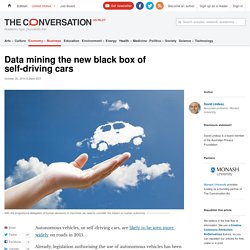
Already, legislation authorising the use of autonomous vehicles has been introduced in the US states of Nevada, Florida, California and Michigan, with similar legislation being planned for the UK. To date, these laws have focused on legalising the use of autonomous vehicles and dealing, to an extent, with some of the complex issues relating to liability for accidents. But as with other emerging disruptive technologies, such as drones and wearables, it is essential that issues relating to user privacy and data security are properly addressed prior to the technologies being generally deployed.
Understanding autonomous vehicles There is no single, uniform design for autonomous vehicles. This means that the privacy and data security problems arising from autonomous vehicles depend upon the precise technologies applied in any particular design. Automobile sensors may usher in self-driving cars. Businessinsider. BI Intelligence Self-driving cars are no longer a futuristic idea.

Companies like Mercedes, BMW, and Tesla have already released, or are soon to release, self-driving features that give the car some ability to drive itself. How Self-Driving Cars Work: The Nuts and Bolts Behind Google's Autonomous Car Program. Being able to commute back and forth to work while sleeping, eating, playing Trivia Crack or catching up on your favorite blogs in Feedly is a concept that is equally appealing and seemingly far-off and too futuristic to actually happen.
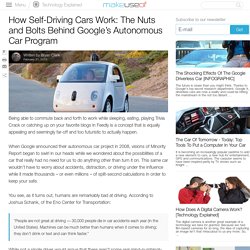
When Google announced their autonomous car project in 2008, visions of Minority Report began to swirl in our heads while we wondered about the possibilities of a car that really had no need for us to do anything other than turn it on. This same car wouldn’t have to worry about accidents, distraction, or driving under the influence while it made thousands – or even millions – of split-second calculations in order to keep your safe. You see, as it turns out, humans are remarkably bad at driving.
According to Joshua Schank, of the Eno Center for Transportation: Stanford engineering students teach autonomous cars to avoid obstacles. Stanford Report, June 29, 2015 The best way to survive a car accident is to avoid collisions in the first place.

Professor Chris Gerdes' engineering students are developing algorithms and pop-up obstacles that could lead to safe autonomous driving. By Bjorn Carey Video by Kurt Hickman Stanford engineering students have been testing an obstacle-avoidance algorithm for autonomous vehicles, using a pop-up obstacle they rigged up from a tablecloth and a leaf blower. One promise of autonomous driving is not to simply survive accidents, but to avoid them altogether. "We're trying to develop a control algorithm that can safely use all of the car's performance capabilities to avoid obstacles and safely perform on a public road," said Joseph Funke, a mechanical engineering graduate student in Professor Chris Gerdes' Dynamic Design Lab.
This called for an obstacle that met several criteria. When confronted with an obstacle, the controller is trying to achieve several objectives at once. Top misconceptions of autonomous cars and self-driving vehicles. Self-driving cars are a rapidly evolving technology which only a few years ago was still considered science fiction.
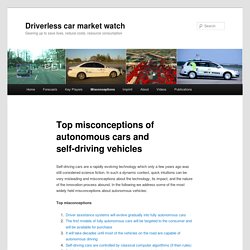
In such a dynamic context, quick intuitions can be very misleading and misconceptions about the technology, its impact, and the nature of the innovation process abound. In the following we address some of the most widely held misconceptions about autonomous vehicles: Top misconceptions This list of misconceptions can be used to : Delphi Drive. Background A first trip of its kind, the team and car traveled nearly 3,400 miles and ended in New York City, New York, making this America’s first and longest coast-to-coast drive by an autonomous driving vehicle.

The journey, announced earlier this month, started out on March 22, 2015 from Treasure Island, located in the San Francisco Bay near the mid-point of the San Francisco-Oakland Bay Bridge in northern California. Avoiding Crashes with Self-Driving Cars. Over the coming years, the advanced safety features that are being developed will increasingly be linked into larger systems that will eventually allow cars to drive themselves.
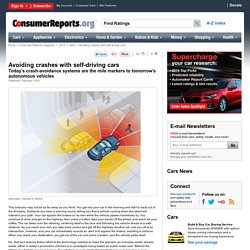
The benefits in terms of safety and convenience could be significant. Autonomous vehicles could help reduce crashes caused by human error, ease congestion, extend the driving years of the aging boomer population, and allow those who are visually or physically impaired to have greater mobility. But are we ready for them? “It’s all about the T word—trust,” says John Hanson, Toyota’s national manager, advanced technology and business communications. “There has to be a level of trust that you have that the vehicle is going to perform the way you think it’s going to perform.”
“Getting a car that can operate with the reliability that today’s cars do is a staggering challenge,” says Bryant Walker Smith, fellow at the center for automotive research at Stamford University. Self-Driving Cars: 5 Problems That Need Solutions. Google recently released data showing that its self-driving cars have been involved in 11 minor crashes over the past six years, which has raised questions about when such autonomous vehicles will be ready for prime time.
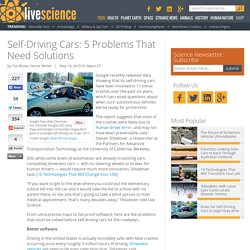
The report suggests that most of the crashes were likely due to human driver error, and may not have been preventable, said Steven Shladover, a researcher at the Partners for Advanced Transportation Technology at the University of California, Berkeley. Still, while some levels of automation are already in existing cars, completely driverless cars — with no steering wheels or brakes for human drivers — would require much more innovation, Shladover said. [10 Technologies That Will Change Your Life] From ultra-precise maps to fail-proof software, here are five problems that must be solved before self-driving cars hit the roadways.
Better software Given existing software, "that is amazingly difficult to do," he said. Better maps Better sensors. Two self-driving cars avoid each other on Californian roads. A self-driving Audi owned by Delphi Automotive took “appropriate action” to avoid one of Google’s self-driving Lexus cars after it cut it off on a Californian road in a rare meeting of driverless vehicles.
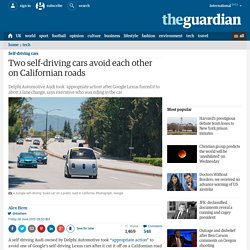
John Absmeier, who was travelling in his company’s car at the time, said the Delphi Audi was forced to abort its lane change in the incident, which happened earlier this week. The incident was initially reported as a “close call” by Reuters, which cited Absmeier’s comments, but both self-driving car companies involved have since been at pains to state the incident was being used as an example of the cars operating safely. A Delphi spokeswoman, Kristin Kinley, told Ars Technica: “The story was taken completely out of context when describing a type of complex driving scenario that can occur in the real world.
6 Simple Things Google's Self-Driving Car Still Can't Handle. Self-Driving Cars Are Legal, But Real Rules Would Be Nice. Self-driving cars are legal in the United States.
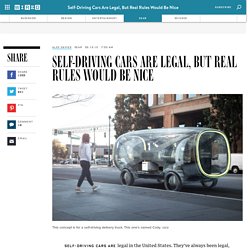
They’ve always been legal, because they’ve never been outlawed. This is America, after all, where if no one says you can’t do it, you can totally do it. But as automakers and others close in on making the technology commercially available—cars with at least some autonomous capabilities could be on the road within three to five years—such de facto legality is hardly reassuring.
Eventually, state and federal policymakers will have to come up with rules. That’s fine, because everyone in this game wants rules, so they know the guidelines they’re playing under, from an early stage. The problem is, policymakers are poorly equipped to decide just how to regulate robo-cars. But this technology is charging ahead, despite the lack of a coherent national policy, and a patchwork of rules from the few states that have legislation on the books. Self-Driving Cars and Insurance. Each new generation of cars is equipped with more automated features and crash avoidance technology. Indeed, many of today’s high-end cars and some mid-priced ones already have options, such as blind-spot monitoring, forward-collision warnings and lane-departure warnings. These will be the components of tomorrow’s fully automated vehicles. At least one car manufacturer has promised to have fully automated cars available by the end of the decade.
Except that the number of crashes will be greatly reduced, the insurance aspects of this gradual transformation are at present unclear. However, as crash avoidance technology gradually becomes standard equipment, insurers will be able to better determine the extent to which these various components reduce the frequency and cost of accidents. A study by the Insurance Institute for Highway Safety (IIHS) has found that improvements in design and safety technology have led to a lower fatality rate in accidents involving late model cars. What will be the economic, social and legal implications of self-driving cars? Driverless car market watch.
As self-driving car technology matures, politicians and regulators find themselves called to action. But the technology is a moving target and views about the technology’s path and impact vary widely. So how should policy makers approach the subject? Here are five guiding principles proposed by Marc Scribner, a transportation and telecommunications policy specialist and research fellow at the Competitive Enterprise Institute.
Scribner only discussed the principles briefly at a recent presentation at the Cato Institute. In the following I supplement each of his five bullet points with my interpretation: Self-Driving Cars Will Make Us Want Fewer Cars. The companies developing self-driving cars say handing control over to the machines will make the future a far better place. Once robot chauffeurs are here, they say, the number of car crashes will plummet. Liberated from the need to keep our hands on the wheel and eyes on the road, drivers will become riders with more time for working, leisure, and staying in touch with loved ones.
We’ll free ourselves from the archaic model of the multi-car household. And we won’t waste so much space parking the damn things. Avip. 7 Ways Self-Driving Cars Could Impact States and Localities. A transportation network where cars and trucks no longer need drivers seems tantalizingly close. Google, Carnegie Mellon University and automakers are testing out their own autonomous vehicles. The federal government has started to plan so that vehicles can communicate with each other. But the reality is the country will still have to wait several years before the vehicles leave the experimental stage. Still, a transportation network where computers pilot vehicles down city streets and highways could radically reshape how states and localities build, manage and govern their roads.
Local officials don’t want to be caught off guard by those changes, and several of them discussed the challenges at the Transportation Research Board’s annual meeting in Washington, D.C., this week. Not all future tech is new The rumble strips are becoming more common, because they help humans avoid “roadway departures” that lead to 51 percent of U.S. motor vehicle fatalities. Regulations could spur innovation. » The Era of Self Driving Cars Navigant Research. Autonomous vehicles promise to reduce traffic congestion and vehicle emissions while increasing safety. Forbes Welcome. Google warns DMV not to over-regulate self-driving cars - Sacramento Business Journal. California Department of Motor Vehicles chief counsel Brian Soublet speaks at a workshop… more Allen Young | Sacramento Business Journal Google company officials warned the California Department of Motor Vehicles on Tuesday against establishing a government process for measuring the safety of driverless cars.
Google representatives spoke Tuesday morning at a public workshop attended by more than 100 car manufacturers, state workers, lobbyists and safety advocates. Google (NASDAQ: GOOG) officials argued that the technology behind autonomous vehicles is too intricate for state government representatives to fully grasp -- and therefore regulate. Google instead suggested that the tech giant show regulators its own safety process. Uber employee of the future: The self-driving car. Uber recently poached 40 of the scientific minds working at Carnegie Mellon's National Robotics Engineering Center. Uber and Carnegie Mellon already had a partnership to work on robotics formed this past February that would include the creation of the Uber Advanced Technologies Center in Pittsburgh.
Uber will eventually replace all its drivers with self-driving cars. 6 things I learned from riding in a Google Self-Driving Car. Last week, a friend and I got a sneak peek at Google's new self-driving cars. In addition to spending an afternoon cheating on my Intergalactic SpaceBoat of Light and Wonder, I got to chat with the engineers about the project. 1. Human beings are terrible drivers. We drink. We doze. Let the Robot Drive: The Autonomous Car of the Future Is Here. Let the Robot Drive: The Autonomous Car of the Future Is Here. Green lights for our self-driving vehicle prototypes.
Future-of-driverless-cars. 812115. When Google Self-Driving Cars Are in Accidents, Humans Are to Blame. In August 2011, on one of the main roads that runs through Google’s headquarters in Mountain View, California, a Prius—one of the cars in Google’s fleet of autonomous vehicles—caused a fender-bender. The accident happened, naturally, because there was a human behind the wheel. That's according to a new report by Google about its self-driving car project, a document that tallies every accident since it began testing its 32 vehicles on the roads in 2009. That sounds like it could be a massive dataset, considering the tens of thousands of accidents that happen on American roadways each year.
It actually isn’t: “In the six years of our project, we’ve been involved in 12 minor accidents during more than 1.8 million miles of autonomous and manual driving combined,” Google wrote. Monthly reports – Google Self-Driving Car Project. Google Self-Driving Car Project.